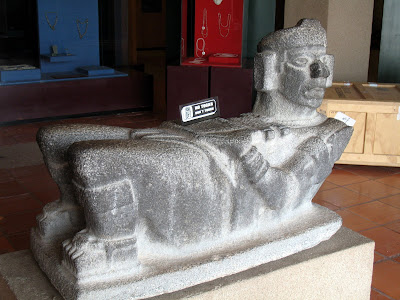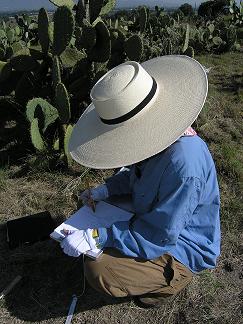Chacmool Cake
This cake combines three interests of mine, Mesoamerica, cakes, and sculpting into one hobby. It is also a follow-up, of sorts, to the Coyolxauhqui cake that I did earlier this year. I did this one for a friend as well, friend M as a birthday/celebration cake of sorts. M is interested in the physical anthropology side of archaeology (i.e. bones). So I figured that some kind of sacrifice stone/skull rack theme was in order. I will attempt a tzompantli one of these days, but they are awfully repetitive (rows of skulls) and a cake (unless it was huge) could only give an impressionistic view of the whole. So I went with a probable sacrifice stone/sculpture that I haven’t attempted yet, a chacmool.
A chacmool is a type of sculpture “in the round” that popped up in Mesoamerican sites over one thousand years ago. As far as I know, they number in a few dozen at most. Their purpose is not entirely clear, though their general iconography combined with a vessel or plate positioned suspiciously over their chests, and their location on or around temples is strongly suggestive of religious offerings and sacrifice.
Chacmools are found in host of different Mesoamerican centers but the two most recognizable ones (and the ones where the largest amounts have been found) are Tula and Chichen Itza. There are differences among chacmools in both execution and iconography, but in general they are stone statues of reclining figures with their knees drawn up and their hands holding a plate or vessel over their chest/stomach area and their heads pulled up as if they are doing a sit-up with their heads facing towards one side. There are variations in clothing although most seem to have loincloths and some kind of necklace or pendant. And they all have similar headgear that appears to reference Tlaloc (the rain god). The level of detail and refinement in the features (for example, the face) also vary a great deal. Of course, some of these could have been plastered and painted originally, which may have afforded a level of detail that is no longer apparent. The eyes and mouth in the examples I’ve seen from Tula are really schematic rather than fleshed out like the Aztec example.
I decided to base my cake on a chacmool from Tula. I had several aesthetic and practical reasons to choose this one. This sculpture appealed to me because it has clean lines with the legs and arms not as detached from the blocky body. Also, to my sensibility it appeared less gawky than the Aztec chacmools and less “leggy” than the one from Chichen Itza (see the comparison again here). But most important of all, it is the only one from Tula that still has a head!
The block shape of the body and the square angular proportions of the arms and legs also made it easier to do in cake form. Cake pans do curves in two dimensions (the familiar round edge of the most common type of cake pans) but not so much in adding freestanding arms and legs, at least, not without using way too much fondant to achieve the effect that the cake matrix doesn’t provide. Also, given my disastrous experience with hemispheres (as when I made the UFO cake), I figured blocky was more stable.
Here’s a picture of the Tula chacmool below.

For a rectangular body, I could simply make a square cake. I used my big square cake pan (the one I typically use for groom cakes) that is 12 x 12 inches. First, I used a two layer cake recipe to make two complete cake layers. Next, I cut each layer in half and stacked three of them on top of each other for the cake body.
You can see the layers stacked below.

Using three layers also made contouring for the feet and shoulders and upper back a lot easier too.
I had to mold the feet separately and then attach them on the cake feet cutouts. They are messy of course, but I kind of like the stubby toes perched on giant sandals of the cake. I particular like this close up of the feet below.

For the head, I took the unused half of one of the layers and used my large biscuit cutter to cut out three cake “rounds” that I could stack atop each other to provide the base for the head. You can see the head layers in the process of being messily iced below. I thought that making a tube shaped base for the head and neck and then sculpting the face separately of fondant and attaching it with plastic straw sections would achieve something closer to the appearance of the original sculpture.

I ended up using a combination of appliqué and molding to get the look of the body. I decided to stick with the basically smooth white fondant rather than coloring it grey and making irregular pockmarks (in imitation of the basalt rock used to make the original). I suppose it was an aesthetic choice since I am going for an overall look rather than an exact replica in this case. You can see the body below prior to the attachment of the head.

I attached the head using plastic straws (two) inserted into the cake body and head for stability. You can see it completed and “in situ” below immediately prior to munching.

The initial cut depicting the cake’s stratigraphy.

Here’s a view from the top. I toyed with the idea of putting a faux heart on top of the vessel clasped between the two hands but nixed it in the end. It seemed too obvious and I'm not sure anyone there would have wanted to eat a giant fondant candy heart so it would have gone to waste.

Finally, a picture of me holding the disembodied head after the rest of the chacmool cake had been demolished. I gave it to my committee chair, who else? 

For the head, I took the unused half of one of the layers and used my large biscuit cutter to cut out three cake “rounds” that I could stack atop each other to provide the base for the head. You can see the head layers in the process of being messily iced below. I thought that making a tube shaped base for the head and neck and then sculpting the face separately of fondant and attaching it with plastic straw sections would achieve something closer to the appearance of the original sculpture.

I ended up using a combination of appliqué and molding to get the look of the body. I decided to stick with the basically smooth white fondant rather than coloring it grey and making irregular pockmarks (in imitation of the basalt rock used to make the original). I suppose it was an aesthetic choice since I am going for an overall look rather than an exact replica in this case. You can see the body below prior to the attachment of the head.

I attached the head using plastic straws (two) inserted into the cake body and head for stability. You can see it completed and “in situ” below immediately prior to munching.

The initial cut depicting the cake’s stratigraphy.

Here’s a view from the top. I toyed with the idea of putting a faux heart on top of the vessel clasped between the two hands but nixed it in the end. It seemed too obvious and I'm not sure anyone there would have wanted to eat a giant fondant candy heart so it would have gone to waste.

Finally, a picture of me holding the disembodied head after the rest of the chacmool cake had been demolished. I gave it to my committee chair, who else?



